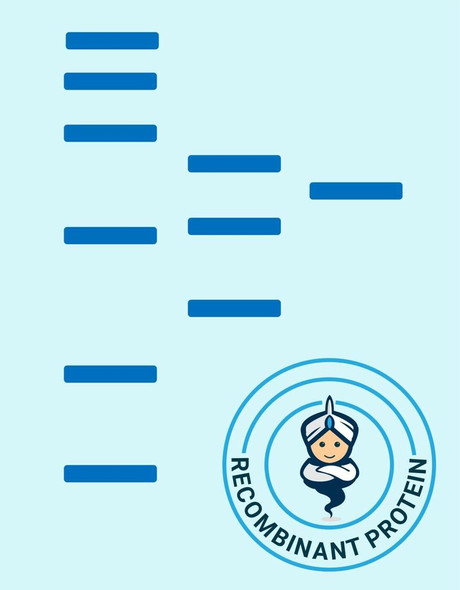Description
| Product Name: | Human B9D2 Recombinant Protein |
| Product Code: | RPPB2841 |
| Size: | 10µg |
| Species: | Human |
| Target: | B9D2 |
| Synonyms: | B9 Protein Domain 2, B9D2, B9 domain-containing protein 2, MKS1-related protein 2, MKSR2, ICIS-1, MKS10. |
| Source: | Escherichia Coli |
| Physical Appearance: | Sterile Filtered colorless solution. |
| Formulation: | The B9D2 solution (0.25mg/ml) contains 20mM Tris-HCl buffer (pH 8.0), 0.2M NaCl, 50% glycerol, 2mM DTT and 1mM EDTA. |
| Stability: | Store at 4°C if entire vial will be used within 2-4 weeks. Store, frozen at -20°C for longer periods of time. For long term storage it is recommended to add a carrier protein (0.1% HSA or BSA).Avoid multiple freeze-thaw cycles. |
| Purity: | Greater than 85% as determined by SDS-PAGE. |
| Amino Acid Sequence: | MGSSHHHHHH SSGLVPRGSH MGSMAEVHVI GQIIGASGFS ESSLFCKWGI HTGAAWKLLS GVREGQTQVD TPQIGDMAYW SHPIDLHFAT KGLQGWPRLH FQVWSQDSFG RCQLAGYGFC HVPSSPGTHQ LACPTWRPLG SWREQLARAF VGGGPQLLHG DTIYSGADRY RLHTAAGGTV HLEIGLLLRN FDRYGVEC |
B9 Protein Domain 2 (B9D2) is a component of the tectonic-like complex which acts as a barrier that prevents diffusion of transmembrane proteins between the cilia and plasma membranes. B9D2 contains a B9 domain protein, which is found solely in ciliated organisms. B9D2 is upregulated throughout mucociliary differentiation.
B9D2 Human Recombinant produced in E.coli is a single, non-glycosylated polypeptide chain containing 198 amino acids (1-175) and having a molecular mass of 21.6 kDa.B9D2 is fused to a 23 amino acid His-tag at N-terminus & purified by proprietary chromatographic techniques.
| UniProt Protein Function: | B9D2: Component of the tectonic-like complex, a complex localized at the transition zone of primary cilia and acting as a barrier that prevents diffusion of transmembrane proteins between the cilia and plasma membranes. Defects in B9D2 are the cause of Meckel syndrome type 10 (MKS10). MKS10 is a disorder characterized by a combination of renal cysts and variably associated features including developmental anomalies of the central nervous system (typically encephalocele), hepatic ductal dysplasia and cysts, and polydactyly. Belongs to the B9D family. |
| UniProt Protein Details: | Protein type:Cytoskeletal Chromosomal Location of Human Ortholog: 19q13.2 Cellular Component: centrosome; cytosol Molecular Function:gamma-tubulin binding; protein binding Biological Process: sister chromatid cohesion Disease: Meckel Syndrome, Type 10 |
| NCBI Summary: | This gene encodes a B9 domain protein, which are exclusively found in ciliated organisms. The gene is upregulated during mucociliary differentiation, and the encoded protein localizes to basal bodies and cilia. Disrupting expression of this gene results in ciliogenesis defects. [provided by RefSeq, Oct 2009] |
| UniProt Code: | Q9BPU9 |
| NCBI GenInfo Identifier: | 226371646 |
| NCBI Gene ID: | 80776 |
| NCBI Accession: | NP_085055 |
| UniProt Related Accession: | Q9BPU9 |
| Molecular Weight: | 19kDa |
| NCBI Full Name: | B9 domain-containing protein 2 |
| NCBI Synonym Full Names: | B9 domain containing 2 |
| NCBI Official Symbol: | B9D2�� |
| NCBI Official Synonym Symbols: | MKS10; MKSR2; ICIS-1; JBTS34�� |
| NCBI Protein Information: | B9 domain-containing protein 2 |
| UniProt Protein Name: | B9 domain-containing protein 2 |
| UniProt Synonym Protein Names: | MKS1-related protein 2 |
| Protein Family: | B9 domain-containing protein |
| UniProt Gene Name: | B9D2�� |
| UniProt Entry Name: | B9D2_HUMAN |






